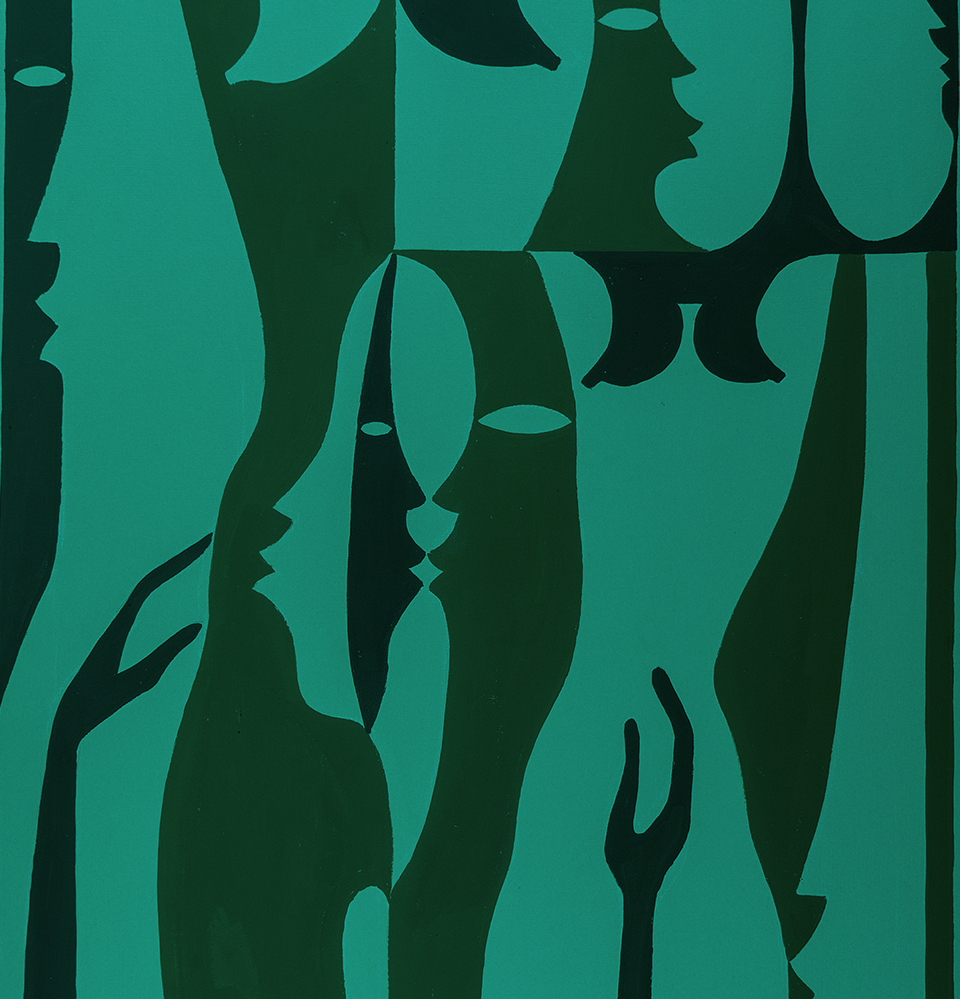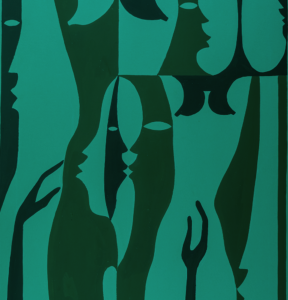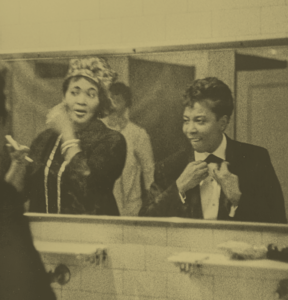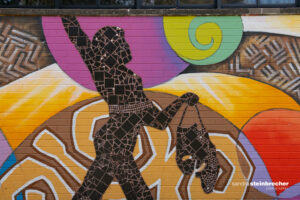Call Me By My Name – Tell Me In Private: The Practice of Berry Horton
LaMar R. Gayles, Jr.
In the song “MONTERO (Call Me By Your Name),” musician Lil Nas X alludes to tensions between Black and Queer identity as he says: “I caught it bad yesterday/You hit me with a call to your place/Ain’t been out in a while anyway.” Despite the stigma attached to terms like “Gay” and “Queer” in the mid-twentieth century, some Black artists still strove to explore themes connected to minority sexual identities. Among them was Berry Horton, an artist deeply connected to the South Side Community Art Center, whose work reflects complex intersectional social dynamics within Queer Black life in Chicago in ways that recall Nas X’s twenty-first century explorations.
Reflecting on an exhibition at Houston’s Redbud Gallery which showcased some of Horton’s more erotic work, art critic Raphael Rubinstein wrote “I was in the presence of a double miracle: it was miraculous that such transgressive art had been made in the first place, and equally miraculous that these scandalous drawings by an obscure artist had survived at all.”[1] Beyond the wonder Rubinstein cites in the fact that this work was made and survived, it is especially valuable in the context of EMERGENCE to draw attention to how deeply embedded Horton’s work was in the flourishing Gay and Lesbian scene in Bronzeville, as Chicago’s near South Side historically Black neighborhood was (and is still) called. In this essay, I seek to explore how Horton’s practice merges elements of mid-century design with the visual aesthetics of chimeric hybridity and allusions to the decorative as a means of queering the subjects in his work. This practice was honed and fostered through Horton’s entanglements and deep–rooted connection to the Queer present in Bronzeville during his lifetime.
The first set of works by Horton I explore are large–scale works that may have been made for a broader public, in contrast with smaller works that are more sketch–like and could be seen instead as private explorations. The first work I consider, Untitled (Couple) presents a bare-chested Black figure with curved breasts juxtaposed over an ambiguous Black figure with a flat bare chest. Horton creates both figures using thick dark lines and endows them with an African mask-like aesthetic. This is a piece in which Horton depicts straight couple but works to Queer them through a decorative treatment of their bodies which makes them seem more alike than different.
Another work, Untitled (Abstract Bodies) , presents a complex abstract geometric composition consisting of a range of human silhouettes interacting with one another’s bodies, in subtle shades of dark brown, beige, and sepia. This painting functions as an example of mid-century design that does not explicitly depict sexual activities but alludes to these acts through the way which the figures interact with each other, almost as if their bodies are intermingled or entangled together.
These works bring Black sexuality—something not often evoked or referenced overtly in this period—to the viewer’s attention. Horton’s works illustrate a unique social phenomenon in Black culture as they reveal the interplay between Black persons engaging in sexual acts. Since these images seem scaled for display, they suggest a possible acceptance of gender and sexual fluidity within Bronzeville culture in his time period.
In more private explorations, Horton often blended elements of the imagination to create hybrid imagery, visual depictions that toy with sexuality, gender, and sexual pleasure. An example of such works is the chimera–like Untitled (Horse-Woman) , which depicts a zoomorphic Black femme-presenting figure wearing a church-hat with a blazer on her human torso handing from which are a set of breasts with large nipples and areolas, but as we follow her body we see the bottom half becomes that of a horse (with her horse legs and feet accented by heeled-boots) dangling between whose legs is a rather large horse-like penis. This piece can be read in a number of ways, but here I call attention to how this work presents the primality of sex as an act and how specific figures Horton interacted with might have been experimenting or playing with gender and sexuality. Another work building on this type of sexual or erotic trope is Untitled (Masked Woman with Tail) in which Horton depicts another zoomorphic figure, but here they are engaging in self-pleasure. The figure here is drawn with a mask-like face on their head and another mask-like face on their rear end with a tail-like tongue extending out and penetrating one of the orifices, while the main figure has a thin, tail-like penis extending out toward their smiling, mask-like face, which extends its own tongue in a gigantic lick. This piece comedically references some of the energy of masturbation while also alluding to the almost impossible feat of auto-fellatio. A piece which directly references human sexuality without many animal allusions is Untitled (Orgy) . In it, Horton depicts a group of Black figures engaging in sexual acts, all of which are depicted using Afrocentric motifs that allude to masking traditions in Africa. In this work, rather than delving into the primal nature of sex, Horton suggests sexuality as a form of community building and group interaction that exists in the background, evident through the figures’ design—which might seem purely decorative, until further inspection reveals a clearly sexual subject.
Together, these works demonstrate that the context in which Horton created his work permitted him to experiment with gender and sexuality, drawing on the imagination and playing with hybrid imagery across a range of decorative and representational strategies as a means of queering a variety of subjects. Yet, we must also begin to conceptualize Horton’s body of work through the context of the mid twentieth century and its depictions and understandings of Black Queer persons. By doing so we will be able to understand how Horton’s public work differs from his more personal explorations. We can thus begin to see the latter works as Horton’s efforts at defining and visualizing his own identity and sexual interests.
In the October 2, 1952 issue of Jet magazine, the article “The Truth About … Female Impersonators” clearly lays out some social perspectives and lived experiences of drag performers in Black spaces and nightlife during the early to mid–twentieth century. The article illustrates the fact that during the 1950s it was commonly understood that female impersonators or drag performers (clearly associated at that time with Queerness) were popular in Black entertainment in the early to mid–twentieth century.
The author begins the article by announcing that “nearly every big US Negro community has—or has had…. one night club where swishing, clean-shaven men dress in women’s clothes and entertain cash customers.” It is hard to disentangle language that is visibly transphobic (and even more so in a twenty-first century context) from the fact that an article like this still can provide important evidence of the activities of gender– and sexually–nonconforming communities and individuals in the mid–twentieth century. The article asserts that “in many mannerisms female impersonators are often more feminine than real women, but many others are grotesque caricatures of real women.” This quote illustrates a dichotomy that is present even today, as some communities and allies see and acknowledge trans women as women and others invalidate their lives and experiences by insisting on calling them men. The article then references an unnamed Chicago nightclub whose headlining performer invites a photographer to document her preparations as she transmogrifies her body from one apparent gender into another. Published in the nationally circulated Jet in the 1950s, the article illustrates a national understanding of Black nightclubs as potentially hosting what would today be called drag performances. More locally, the article notes that “in Chicago female impersonators always have big audiences at Joe’s DeLuxe Club.”[2]
Throughout the article, the author conjures a larger Black reading audience grappling with the presence of Black Queer performers in public spaces. The author asks some rather offensive questions, such as “is society now more tolerant of the deviant male and does this encourage men to wear women’s clothing?” and then answers these questions in a deeply unsatisfying way, explaining that society is more comfortable with deviancy but still sees feminine men as a problem and will “lock them up for their perversions.” The article enforces external societal norms rather than looking at how people refer to themselves, although it also notes that “men who wear women’s clothes are called transvestites but rarely do they use (that word) … themselves. They call their costumes ‘drags,’ and themselves ‘Gay.’” This illustrates the agency presented by Queer persons in this period who were working to define their own identities and interests.
Additionally, we must understand that following the 1950s most Queer performances were pushed (from main-stage) to nightlife with one of the few annual exceptions being Halloweeen. In the 1952 Jet article the author writes, “for transvestites who go all out [wearing exclusively feminine clothing], Halloween is their big night” and claims that in big cities, working–class men save all year long for one big “splurge” on women’s clothes. In the November, 19 1964, issue of Jet, another article, “‘Fairy’ Tales Come True in Chicago on Halloween” recounts a Halloween night in Chicago’s Queer communities.[3] The author notes that at the annual Finnie’s Club Ball, the 3000-person-capacity was met, with over 200 contestants both Queer men and women competing for trophies. The article refers to “wish-they-were-men,” a clear reference to masc-presenting Queer women and masculine trans persons. While Chicago entertainment venues clearly included Queer and non-cisgender representation throughout the twentieth century, contemporary descriptions constantly subvert Queer identities and reduce them to costumes or parodies.
By applying the socio-cultural context provided by the articles from the mid–twentieth century, we can clearly see that throughout the period Black Queer performers functioned in both very public venues and in smaller nightlife venues.[4] Most of Horton’s work is dated between the 1930s and 1960s during which he experienced seeing Queer performers in larger stages and in smaller venues. This causes us to interpret Horton’s public work to take on more androgynous and abstract representation. Then in his more private work we see Horton being able to explicitly explore the intersections between his own sexual interests and elements from his fantastical imagination by composing chimeric figures (blending aspects from different genders and animals) engaged in sexual acts with themselves and each other.
Raphael Rubinstein, “Berry Horton.” Art in America, October 13, 2016. https://www.artnews.com/art-in-america/aia-reviews/berry-horton-62243/
- “The Truth About … Female Impersonators.” Jet Magazine, October 2, 1952.
- “‘Fairy’ Tales Come True in Chicago on Halloween.” Jet Magazine, October 1964.
Cabello, Tristan. “Constructing Black Homosexuality on Chicago’s South Side: The Black Press, Queer Identities, and the Civil Rights Movement, 1950-1965.” Windy City Times. March 28, 2012.






